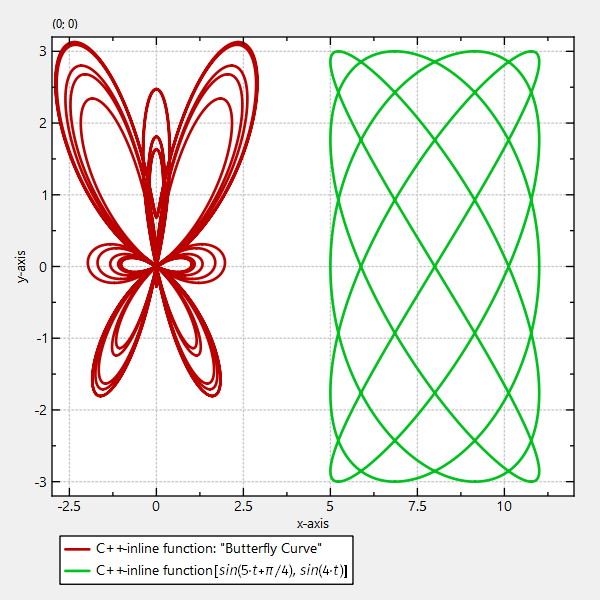| .. | ||
| CMakeLists.txt | ||
| evalcurve_and_lib.pro | ||
| evalcurve.cpp | ||
| evalcurve.pro | ||
| README.md | ||
Example (JKQTPlotter): Plotting Parametric Mathematical Curves as Line Graphs
Basics
This project (see ./examples/evalcurve/) demonstrates how to plot mathematical functions as line graphs with JKQTPXYFunctionLineGraph. The functions may be defined as static C functions, C++ functors or c++ inline functions. The functions may simply depend on the parameter t, or on t and a vector of parameters.
The class uses an adaptive algorithm, which determines by the local slope, at how many points (or how close points) the functor has to be evaluated.
If you want to evaluate the parametric function explicitly, you can use JKQTPXYLineGraph or JKQTPXYParametrizedScatterGraph and have a look at the example ./examples/parametriccurve.
[TOC]
Simple C++ inline function
The example shows how to plot a simple C++ inline function:
JKQTPXYFunctionLineGraph* func1=new JKQTPXYFunctionLineGraph(plot);
func1->setPlotFunctionFunctor([](double t) ->QPointF {
return QPointF(
sin(t)*(exp(cos(t))-2.0*cos(4.0*t)-jkqtp_pow5(sin(t/12.0))),
cos(t)*(exp(cos(t))-2.0*cos(4.0*t)-jkqtp_pow5(sin(t/12.0)))
);
});
func1->setTRange(0, 12.0*JKQTPSTATISTICS_PI);
func1->setTitle("C++-inline function: \"Butterfly Curve\"");
plot->addGraph(func1);
Note that here a functor is defined, which calculates the points on a Butterfly Curve, i.e. a function mapping a parameter t to a two-dimensional point QPointF with complex functions for x and y. This function is evaluated on a range of values for t, set by
func1->setTRange(0, 2.0*JKQTPSTATISTICS_PI);
Simple C++ inline function with Parameters
JKQTPXYFunctionLineGraph allows to use more complex functors alternatively: These depend on the variable tand a vector of parameters. Here is an example:
func2->setPlotFunctionFunctor([](double t, const QVector<double>& params) ->QPointF {
return QPointF(
3.0*sin(params[0]*t+params[2])+8.0,
3.0*sin(params[1]*t)
);
});
// now we define the 3 parameters of the function
func2->setParamsV(5, 4, JKQTPSTATISTICS_PI/4.0);
// and define the range over which to evaluate
func2->setTRange(0, 2.0*JKQTPSTATISTICS_PI);
func1->setTitle("C++-inline function $[ sin(5{\\cdot}t+\\pi/4), sin(4{\\cdot}t) ]$");
plot->addGraph(func1);
In the functor we can use the entries in the vector param as function parameters. The values in this vector are defined by
// now we define the 3 parameters of the function
func2->setParamsV(5, 4, JKQTPSTATISTICS_PI/4.0);
Alternatively they can also be taken from a column in the internal datastore. Then you have to call:
func2->setParameterColumn(ColumnID);
instead, where ColumnID is the ID of the column with the parameter values.
Screenshot
This code snippets above result in a plot like this:
Notes
This example describes how to draw 2D parametric curves. For (simpler) 1D-functions f(x) or f(y), see examples/functionplot .
